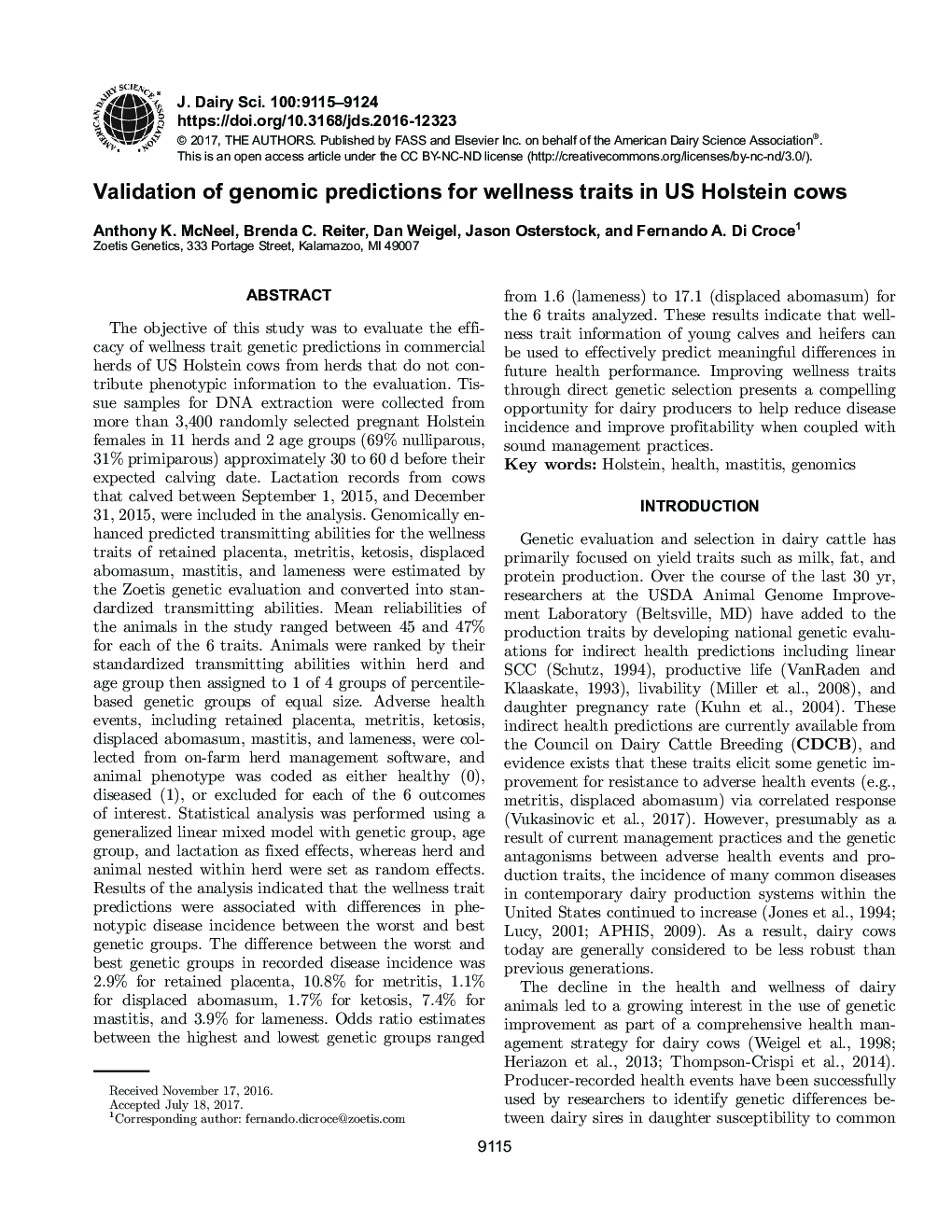| کد مقاله | کد نشریه | سال انتشار | مقاله انگلیسی | نسخه تمام متن |
|---|---|---|---|---|
| 5541679 | 1553846 | 2017 | 10 صفحه PDF | دانلود رایگان |
عنوان انگلیسی مقاله ISI
Validation of genomic predictions for wellness traits in US Holstein cows
ترجمه فارسی عنوان
اعتبار پیش بینی های ژنومی برای صفات سلامتی در گاوهای ایالات متحده هولشتاین
دانلود مقاله + سفارش ترجمه
دانلود مقاله ISI انگلیسی
رایگان برای ایرانیان
کلمات کلیدی
هولشتاین، سلامتی، ماستیت، ژنومیک،
موضوعات مرتبط
علوم زیستی و بیوفناوری
علوم کشاورزی و بیولوژیک
علوم دامی و جانورشناسی
چکیده انگلیسی
The objective of this study was to evaluate the efficacy of wellness trait genetic predictions in commercial herds of US Holstein cows from herds that do not contribute phenotypic information to the evaluation. Tissue samples for DNA extraction were collected from more than 3,400 randomly selected pregnant Holstein females in 11 herds and 2 age groups (69% nulliparous, 31% primiparous) approximately 30 to 60 d before their expected calving date. Lactation records from cows that calved between September 1, 2015, and December 31, 2015, were included in the analysis. Genomically enhanced predicted transmitting abilities for the wellness traits of retained placenta, metritis, ketosis, displaced abomasum, mastitis, and lameness were estimated by the Zoetis genetic evaluation and converted into standardized transmitting abilities. Mean reliabilities of the animals in the study ranged between 45 and 47% for each of the 6 traits. Animals were ranked by their standardized transmitting abilities within herd and age group then assigned to 1 of 4 groups of percentile-based genetic groups of equal size. Adverse health events, including retained placenta, metritis, ketosis, displaced abomasum, mastitis, and lameness, were collected from on-farm herd management software, and animal phenotype was coded as either healthy (0), diseased (1), or excluded for each of the 6 outcomes of interest. Statistical analysis was performed using a generalized linear mixed model with genetic group, age group, and lactation as fixed effects, whereas herd and animal nested within herd were set as random effects. Results of the analysis indicated that the wellness trait predictions were associated with differences in phenotypic disease incidence between the worst and best genetic groups. The difference between the worst and best genetic groups in recorded disease incidence was 2.9% for retained placenta, 10.8% for metritis, 1.1% for displaced abomasum, 1.7% for ketosis, 7.4% for mastitis, and 3.9% for lameness. Odds ratio estimates between the highest and lowest genetic groups ranged from 1.6 (lameness) to 17.1 (displaced abomasum) for the 6 traits analyzed. These results indicate that wellness trait information of young calves and heifers can be used to effectively predict meaningful differences in future health performance. Improving wellness traits through direct genetic selection presents a compelling opportunity for dairy producers to help reduce disease incidence and improve profitability when coupled with sound management practices.
ناشر
Database: Elsevier - ScienceDirect (ساینس دایرکت)
Journal: Journal of Dairy Science - Volume 100, Issue 11, November 2017, Pages 9115-9124
Journal: Journal of Dairy Science - Volume 100, Issue 11, November 2017, Pages 9115-9124
نویسندگان
Anthony K. McNeel, Brenda C. Reiter, Dan Weigel, Jason Osterstock, Fernando A. Di Croce,
